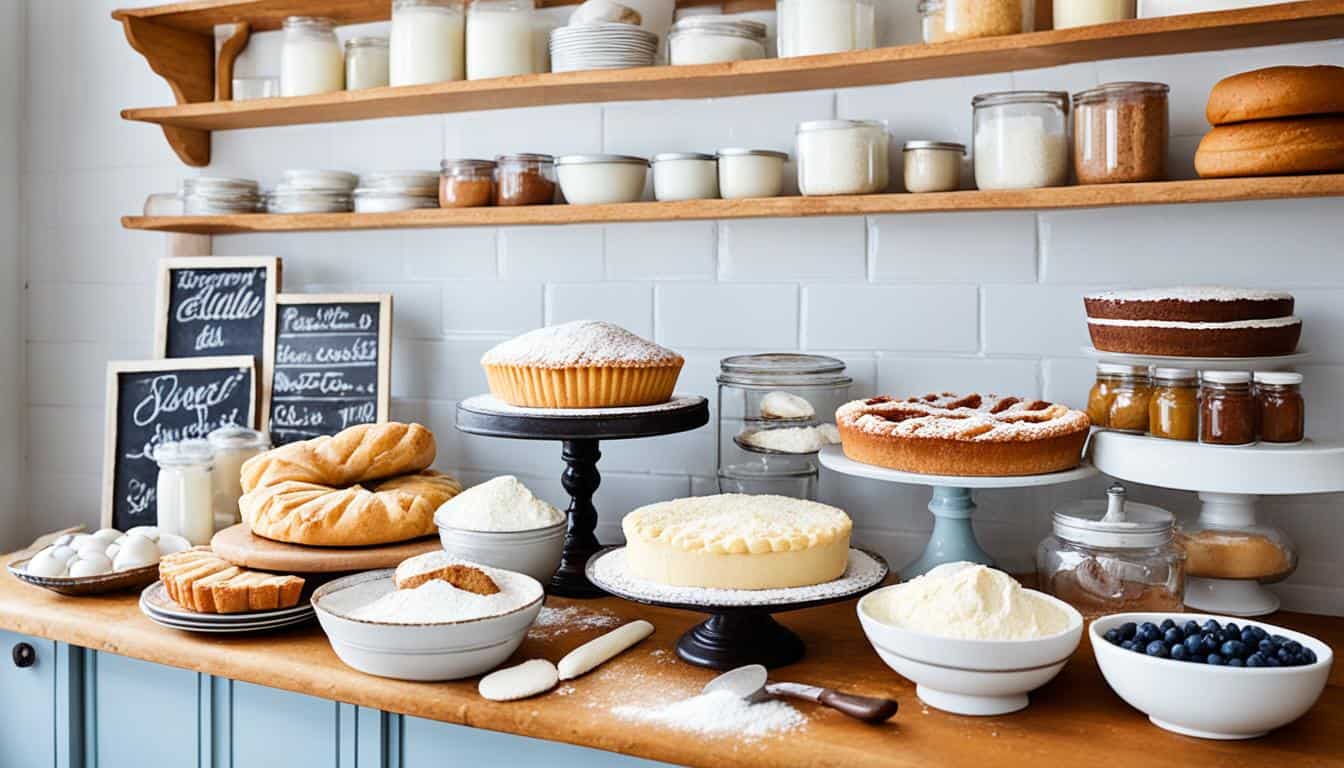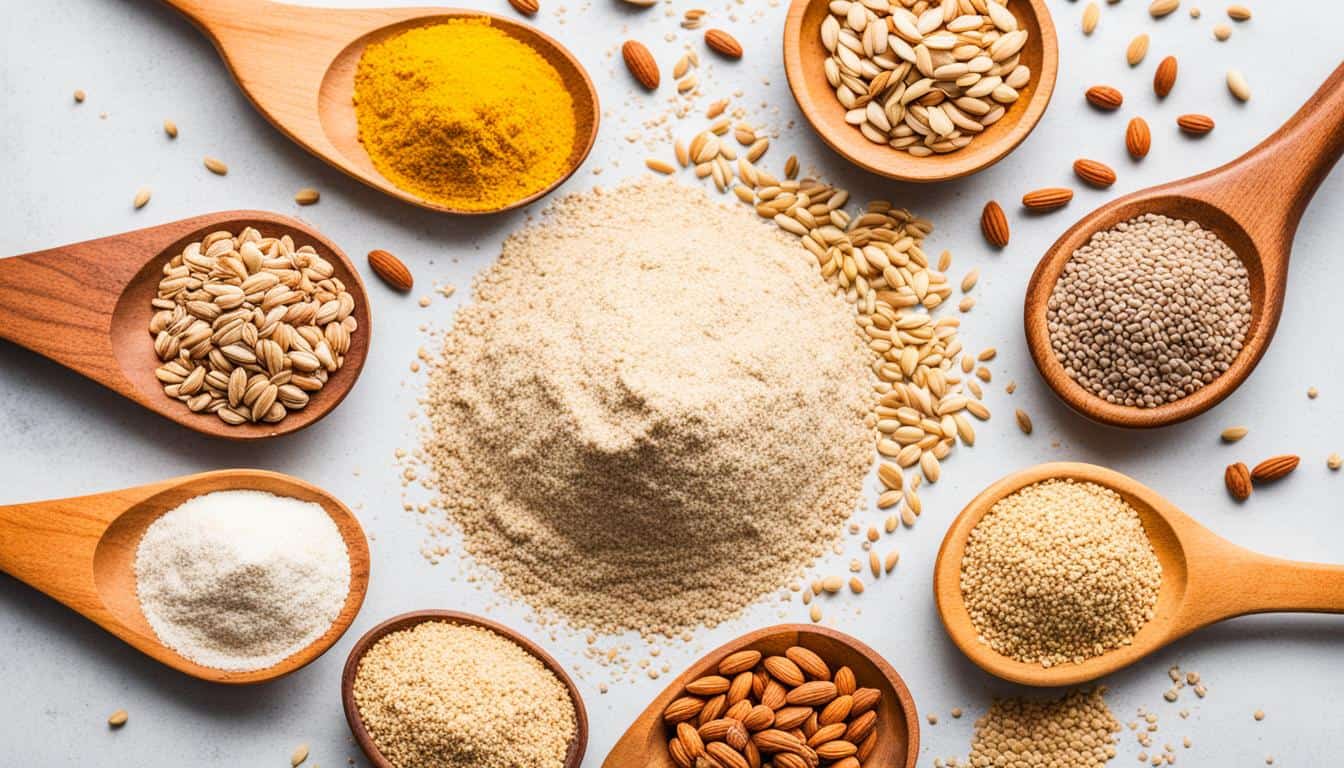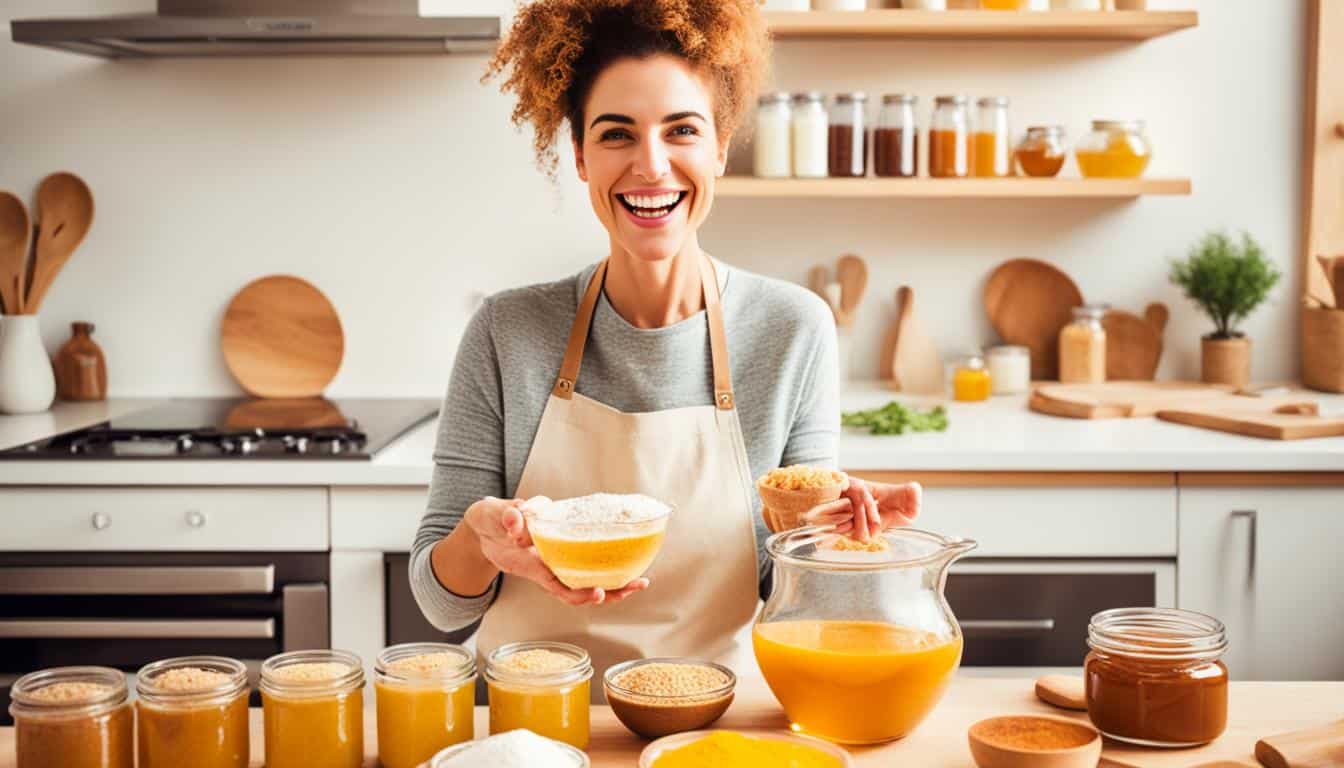Baking pies can seem tough, but with the right tips, you can make perfect pies every time. Let me tell you a story that shows why one tip is key.
A few years ago, I wanted to surprise my family with a homemade apple pie. I carefully measured the ingredients and rolled out the crust. But when it was time to bake, the crust looked pale and not great.
When I cut into the pie, the filling was tasty, but the crust was dense and tough. It wasn’t the flaky crust I wanted. I was puzzled about what went wrong.
Then, I learned a crucial tip: cold dough will produce a flakier pie crust. I had skipped chilling the dough in my excitement. That’s why my crust was bad.
This time, I chilled the dough at every step. The result was a pie with a crust that was flaky and tender. It was amazing.
Now, making perfect pies is easy for me. Over the last 12 years, I’ve made over a thousand pies. I’ve learned the secrets to making perfect pies through trial and error.
Key Takeaways:
- Cold dough produces a flakier pie crust, so make sure to chill the dough at every step.
- Keep butter chunks large for a flakier crust, using butter pieces the size of a walnut half.
- Roll out the crust to have a double layer for a thicker crust that avoids burning and crisping.
- Consider blind baking the crust even if the recipe doesn’t mention it, as it can have a beneficial effect on the bottom crust.
- Bake the crust until it is more deeply browned, not just golden, for a flakier texture.
With these tips, you’ll be on your way to baking perfect pies every time. Next, we’ll explore more about pie-making. We’ll cover everything from the crust to fillings, presentation, and baking. Let’s start our journey to pie perfection!
Mastering the Pie Crust
The pie crust is the key to a great pie. Getting it right means paying attention to details and using the right techniques. Whether you’re making a traditional pie crust or trying new flavors, getting good at pie crust will improve your baking.
Start with top-quality ingredients when making crust from scratch. Traditional recipes often use lard for a flaky texture. But, butter is a tasty substitute that adds flakiness and a buttery taste.
For a flaky crust, keep the butter in big ½” chunks. Put these in the freezer for 10 minutes before mixing. This keeps the butter cold and solid, creating the flaky layers you want.
Use cold water when mixing the ingredients. Cold water, or even ice-cold, stops gluten from forming. This makes the crust light and flaky. Mix the flour with cold butter first, then add water. This coats the butter in flour, stopping gluten too.
Don’t overmix the dough. Stop mixing when it starts to come together. Overmixing makes the crust heavy and solid. Shape the dough into a disk or brick, wrap it in plastic, and chill for at least two hours. This lets the dough hydrate and come together right.
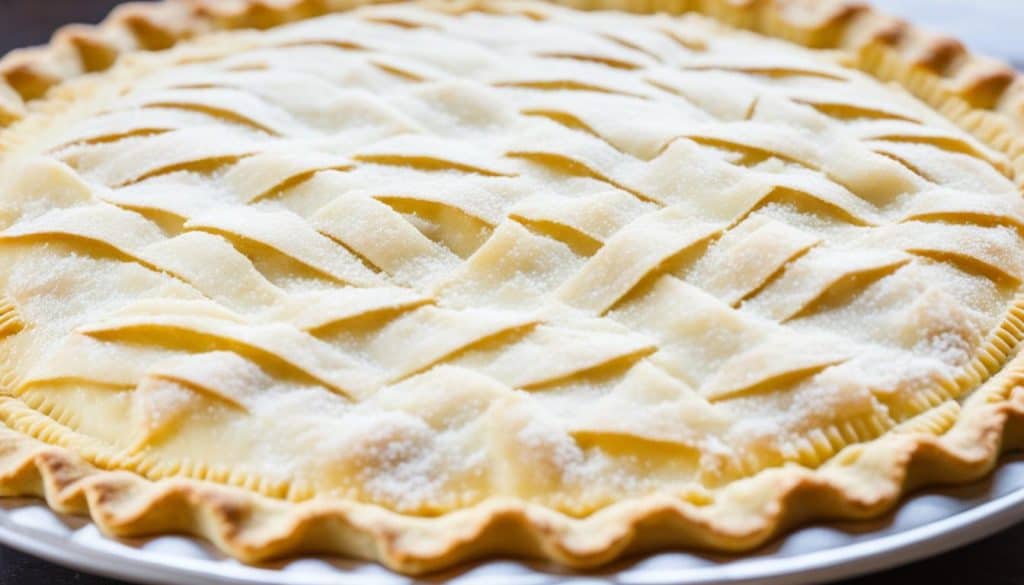
Now, your pie crust is set. Think about how you’ll bake it. The pie plate material affects the crust’s texture. Use refined white sugar as pie weights to prevent the crust from sinking during baking.
For the best results, keep the dough pliable between 68°F and 72°F. This makes it easy to roll out without it getting too sticky. Also, cut the butter into cubes at least half an inch to ensure flakiness.
Don’t hesitate to try new things with your pie crust. While there are classic recipes, adding your own flavors can make the crust special.
Mastering the pie crust will help you make pies that wow your friends and family. So, get your ingredients ready and let’s start baking!
Perfecting the Filling
Baking a perfect pie means focusing on the filling. A great filling can take your pie to new heights. Here are some tips to make your filling perfect:
Choosing the Right Fruit
Choosing the right fruit is key for a tasty pie. Pick fresh fruits that are in season for the best taste and texture. Cut the fruit the same size to cook evenly throughout the pie.
Thickening the Filling
To avoid a soggy crust, thicken the filling right. Use flour or cornstarch for this. Also, add sugar, salt, spices, and herbs to boost the filling’s flavor.
Custard Pies
Custard pies are great warm or cold. For a unique taste, add spices like nutmeg or clove. A bit of bourbon can also make the filling richer.
The filling is what makes a pie special. Try different fruits, flavors, and textures to make your own signature fillings. Enjoy perfecting the filling and let your creativity flow!
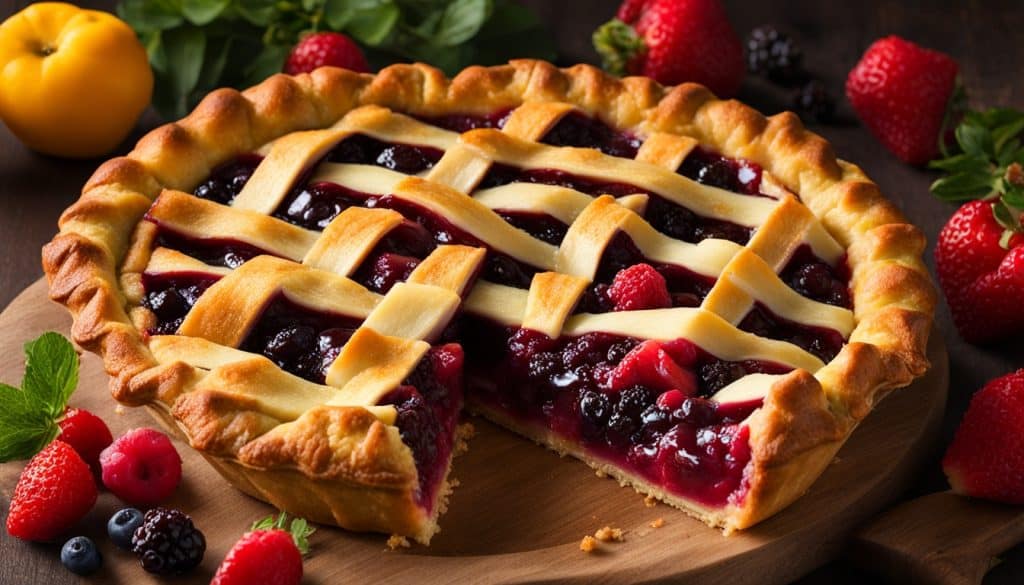
Working with Lattice Pie Crusts
Lattice pie crusts are both tasty and beautiful. They add an elegant look to any pie. To get a perfect lattice crust, follow these expert tips and techniques:
1. Prepare the Dough
Start by rolling out your pie crust into a 12-inch circle, about 1/8 inch thick. This thickness is key for overhang and the lattice topping. Make sure the dough is cold, as warm dough can be sticky and hard to handle.
2. Cut the Strips
Use a sharp knife or a pastry wheel to cut the dough into 12 one-inch strips. These will be the lattice design on your pie.
3. Lay the Strips
Begin by laying 6 vertical strips of dough over the pie filling, spacing them evenly. Use longer strips in the middle and shorter ones at the ends for a balanced look. Leave gaps between the strips to let steam escape, ensuring a crisp crust.
4. Weave the Lattice
Fold back every other strip of dough, then place a horizontal strip across the unfolded ones. Unfold the strips back over the horizontal strip. Keep alternating the folded strips until the lattice is finished. This pattern creates a beautiful lattice design.
5. Refrigerate and Seal
Refrigerate the pie for 20-30 minutes before baking. This chilling helps the lattice shape hold up during baking. To seal the edges, fold any extra dough back onto the pie and pinch it with the bottom crust. This adds a decorative touch.
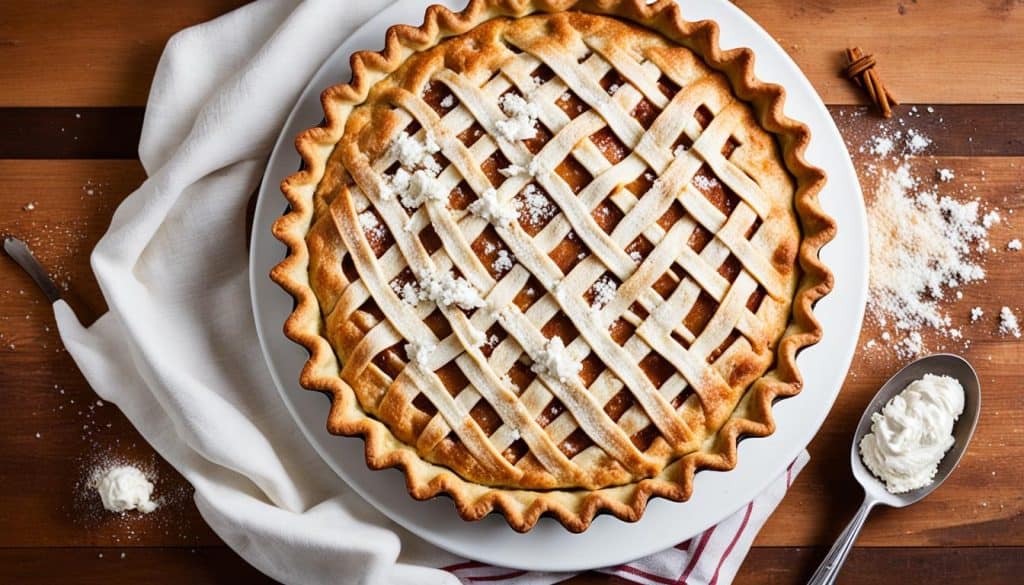
6. Enhance and Bake
Add sparkle and crunch to your pie by brushing it with an egg wash and sprinkling coarse sugar on top. This gives your pie a golden finish. Bake the pie until the crust is golden and the filling bubbles.
Remember, getting better at latticing takes practice. Don’t worry if your first try isn’t perfect. If the pie tastes great, it will still be a hit!
Next up: Section 5 – The Importance of Proper Baking Techniques
The Importance of Proper Baking Techniques
Proper baking techniques are key to making perfect pies every time. It’s not just about the recipe; it’s about the science and art of baking. By using the right methods and focusing on details, you can get tasty and beautiful results. Here are some important techniques every baker should know:
High Initial Temperature
Start by preheating your oven to a high temperature at the start. This high heat helps make a beautiful golden crust and seals in flavors. Then, lower the oven temperature for the rest of baking to cook evenly.
Reduced Oven Temperature
After the initial high heat, reduce the oven temperature for pies with delicate fillings. This stops the edges from getting too cooked or burnt. It lets the filling cook and set properly.
Blind Baking
Blind baking is useful for pies with fillings that don’t need baking or have a short baking time. It means baking the crust before adding the filling. This keeps the crust crispy and flaky, even with moist fillings. To blind bake, put parchment paper in the crust, add pie weights or dried beans, and bake until it’s golden brown.
Using these baking techniques ensures your pie crusts are perfectly baked, golden, and flaky. Remember, practice is key, so keep trying and improving your skills for the best results.
The Benefits of Freezing Pies
Freezing pies is a great way to save time and plan ahead for pie lovers. It makes making pie easier by letting you prepare the crust and filling ahead. This is perfect for busy people or those who bake pie less often.
Freezing pies before baking can make them taste better and have a great texture. The crust gets crispy, and the filling stays fresh. This makes the pie taste amazing.
Restaurants often freeze pies before baking and get great results. Double crust fruit pies work especially well for freezing. They’re perfect for busy times like holidays when you want to bake with little effort.
It’s best to freeze pies fully assembled but not baked. This keeps them fresh until you bake them. Baking a frozen pie takes about 15% longer than a fresh one, but it’s worth it.
Storing frozen pies right is important to keep them tasting good. Keep the crusts in the back or bottom of the freezer to avoid ice crystals. Don’t store them for more than three months, or one month for pre-baked crusts, to keep the flavor.
Freezing pies is a big help in the kitchen, whether you’re an expert or a beginner. They taste fresher and last longer than reheated pies. Plus, they prevent a soggy bottom crust. Use freezing to make your pie-baking easier and more enjoyable.
The Art of Pie Presentation
Pies are a big part of American comfort and are often seen at family gatherings and holidays. The way you present a pie can make a big difference in how it looks and tastes. With some simple tips, you can make your pies not just delicious but also look great.
Decorative Crust Designs
Creating decorative crust designs can make your pie stand out. Use cookie cutters to cut shapes like leaves or flowers from the extra dough. Place these shapes on top of the pie for a beautiful pattern. This adds visual interest and makes your pie look more impressive.
Garnishes and Whipped Cream
Garnishes can elevate your pie’s presentation. Try using frosted cranberries, cinnamon sticks, or edible flowers for a festive look. Serving your pie with whipped cream adds a creamy and indulgent touch. It also adds height and elegance to your pie.
Colorful and Seasonal Ingredients
Using colorful and seasonal ingredients can make your pie look appealing. For fruit pies, use fruit slices with their skins on for vibrant colors and natural decoration. Try different fruits and use seasonal varieties for better flavor and texture.
Attention to Detail
Details are important in pie presentation. Make sure your pie is neatly trimmed and all edges are sealed well. Adding a decorative border or crimping the edges can make your pie look better. Precision in assembling double-crust pies is key to prevent leaks, which can affect the presentation.
By focusing on both taste and looks, you can create a memorable dessert. Experiment with different techniques, like decorative crusts, garnishes, and whipped cream. Let your creativity shine as you master pie presentation.
Conclusion
With the tips and techniques shared here, you can bake perfect pies every time. You’ll learn how to master the crust, make tasty fillings, and present your pies beautifully. These insights will help you get the baking satisfaction you want.
So, next time you’re in the kitchen, grab your rolling pin. Get ready to make delicious pies that will impress everyone. You’ll learn to make any pie shape you want, from traditional to intricate designs.
Don’t forget about the golden-brown crust! Getting that perfect color is easy with a little trick. Just sprinkle or brush milk, egg wash, or butter on before baking. This small step can make your pies even more delicious.
So, what are you waiting for? Try out your new skills and start your pie-baking journey. With dedication and creativity, you’ll soon be sharing perfect pies with family and friends. Happy baking!
